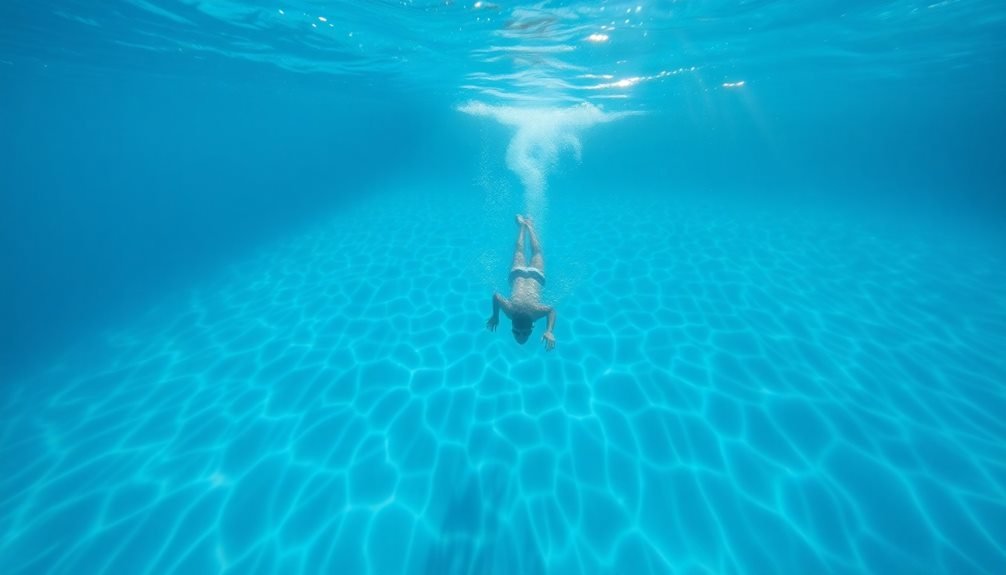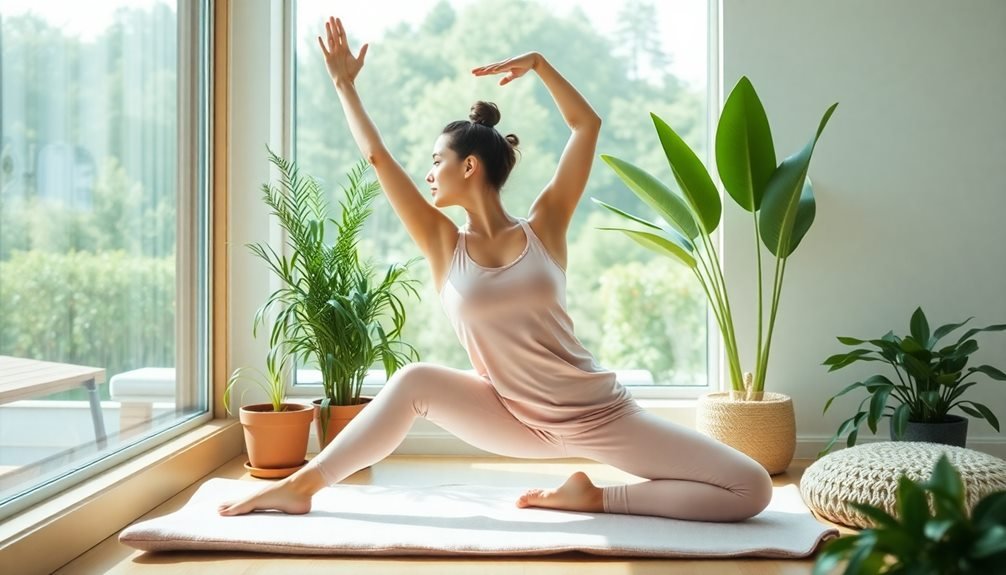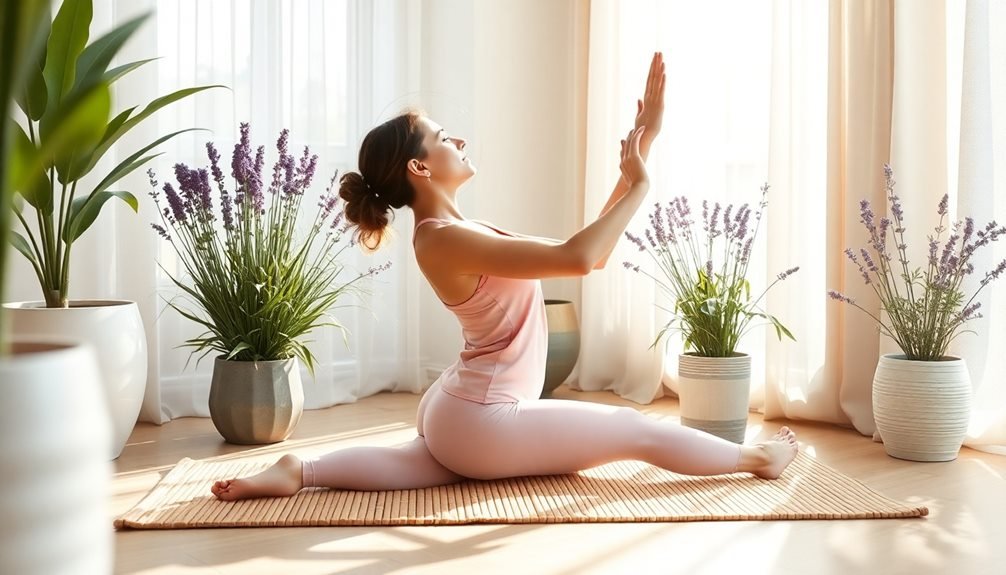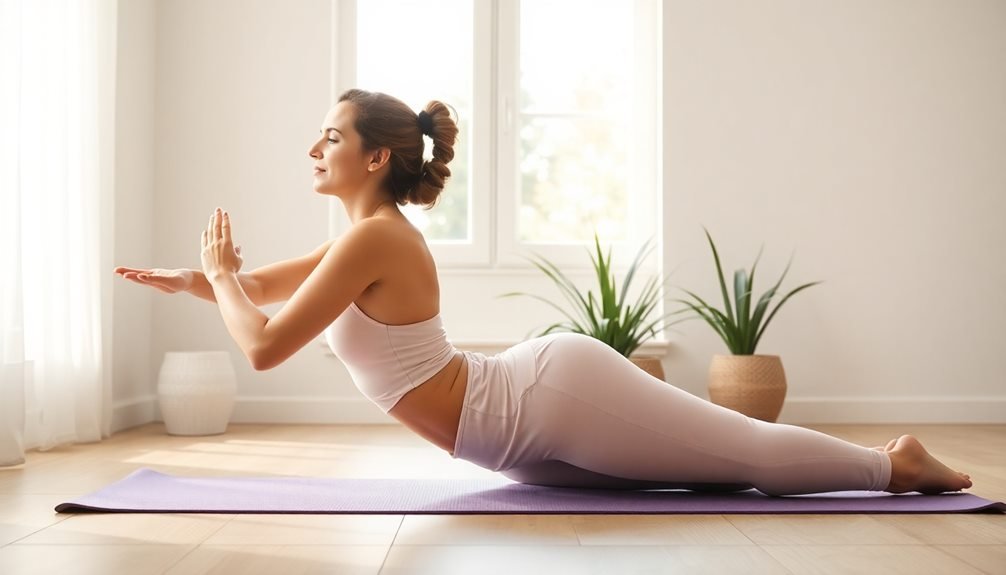Pool workouts offer a unique way to ease your mind while staying active. You'll benefit from water's natural buoyancy, which reduces physical stress and helps you focus on breathing and movement. Start with floating meditation techniques using a pool noodle for support, then progress to gentle stretches that take advantage of water's resistance. The ambient sounds and hydrostatic pressure naturally lower your cortisol levels, reducing anxiety and promoting better sleep. With proper safety measures and basic equipment like a comfortable swimsuit and goggles, you can transform your pool time into a therapeutic sanctuary that nurtures both body and mind.
Benefits of Aquatic Mindfulness

Water's natural buoyancy creates an ideal environment for mindfulness practice while exercising. As you move through the water, you'll notice how it supports your body weight, reducing physical stress and allowing you to focus on your breath and movements more intentionally. This weightless sensation helps quiet your mind and enhance body awareness.
During aquatic mindfulness exercises, you'll experience reduced joint pressure and muscle tension, making it easier to maintain proper form and alignment. The water's resistance provides gentle feedback, helping you stay present and attuned to each movement. You'll find that the pool's ambient sounds – the gentle splashing and rhythmic movements – naturally promote a meditative state.
The combination of water immersion and mindful movement can lower your cortisol levels, decrease anxiety, and improve sleep quality. You'll develop better breathing patterns as you coordinate your movements with your breath, leading to increased oxygen efficiency.
The water's hydrostatic pressure also helps regulate your heart rate and blood pressure, contributing to an overall sense of calm and well-being. These benefits often extend beyond your pool session, helping you maintain mental clarity throughout your day.
Getting Started in Water
Before you enter the water, you'll need to familiarize yourself with essential pool safety rules, including never swimming alone and staying within your depth limit.
You'll want to gather basic equipment such as a comfortable swimsuit, well-fitting goggles, and a swim cap to keep your hair protected.
Starting with the right preparation guarantees you'll have a safe and comfortable experience as you begin your water workout journey.
Basic Pool Safety Rules
When stepping into a pool for exercise, your top priority must be safety and awareness. Don't enter the water if you're feeling unwell, and always wait at least two hours after eating. Confirm you've checked the pool's depth markers and know which areas match your swimming ability.
Before starting your workout, familiarize yourself with the pool's emergency equipment locations, including life rings and reaching poles. You'll need to follow the facility's rules about proper swimwear and shower before entering.
If you're new to pool exercises, consider working out during less crowded hours and staying in the shallow end. Never exercise alone in the pool – there should always be a lifeguard on duty or a workout partner present.
Keep yourself hydrated even though you're in water, and exit the pool immediately if you feel dizzy or exhausted. Watch for signs of overexertion like shortness of breath or muscle cramping.
Remember to maintain a safe distance from other swimmers and stay in designated lap lanes or exercise areas. If you're using pool equipment, confirm it's properly secured and in good condition before your workout begins.
Equipment You'll Need
Getting equipped for pool workouts doesn't require a huge investment. You'll need a well-fitting swimsuit that allows free movement and won't ride up during exercises. A swimming cap helps keep your hair dry and reduces resistance in the water, while goggles protect your eyes from chlorine and improve underwater visibility.
For added resistance and variety, consider purchasing water dumbbells and ankle weights specifically designed for pool use. A kickboard can help you focus on leg exercises and maintain balance during certain movements. Pool noodles are versatile tools that provide support and assist with floating exercises.
If you're planning to do deep-water workouts, a flotation belt will keep you upright and stable.
Don't forget essential safety items: water shoes to prevent slipping on wet surfaces and protect your feet from rough pool bottoms, and a water bottle to stay hydrated during your workout.
If you'll be exercising outdoors, waterproof sunscreen and a hat are vital. For comfort after your session, bring two towels – one for drying off and another for your hair – plus a waterproof bag to carry wet items home.
Floating Meditation Techniques

Learning to meditate out on the water brings a unique dimension to poolside relaxation. When you're floating, your body naturally achieves a state of weightlessness that helps release physical tension and promotes mental calmness.
Start by using a pool noodle under your neck and knees while lying back in calm water. Close your eyes and focus on your breath, noticing how the water gently rises and falls with your chest. You'll want to maintain a comfortable water temperature between 80-85°F (27-29°C) to prevent getting chilled during your session.
Practice the "floating star" position by extending your arms and legs while using a flotation device at your lower back. As you float, concentrate on each limb becoming lighter and more buoyant. Count your breaths slowly from one to ten, then restart if your mind wanders.
For advanced meditation, try the "water lotus" position using a swim belt to keep your torso upright while your legs float in a crossed position. Incorporate gentle hand movements under the water to enhance your mind-body connection.
Begin with five-minute sessions and gradually increase duration as you become more comfortable.
Gentle Pool Stretching Exercises
Basic pool stretches will get your body ready for a relaxing water workout while taking advantage of the pool's natural resistance.
You'll want to start with simple movements like shoulder rolls, ankle rotations, and gentle trunk twists while standing in chest-deep water.
These beginner-friendly stretches help you build flexibility gradually as you learn to work with the water's buoyancy and support.
Basic Pool Stretching Positions
Ease into your pool workout with gentle stretches that take advantage of water's natural buoyancy and resistance. Standing in chest-deep water, you'll find your body feels lighter and more flexible, making it perfect for stretching those tight muscles.
Position yourself near the pool's edge so you can hold on for balance when needed.
- Wall stretch: Face the pool wall, place your palms flat against it at shoulder height, and step back until your arms are fully extended. You'll feel a soothing stretch across your chest and shoulders.
- Hip opener: Hold the pool's edge and lift one knee toward your chest, then rotate it outward in a circular motion. You'll experience a gentle release in your hip flexors.
- Spinal twist: Keep your feet planted shoulder-width apart, extend your arms out to the sides, and rotate your torso slowly left to right. The water's resistance will deepen the stretch naturally.
- Hamstring reach: Float on your back while holding the pool's edge, extend one leg straight up, and gently pull it toward your chest. The water's support helps prevent strain while lengthening tight muscles.
Water Flexibility For Beginners
Flexibility flourishes in the pool's gentle embrace, where water's natural properties make stretching both safer and more effective for beginners. You'll find that water's buoyancy supports your body weight, reducing stress on your joints while allowing for a greater range of motion.
Start your water flexibility routine in chest-deep water with gentle neck rolls and shoulder rotations. Roll your head slowly from side to side, then circle your shoulders forward and backward.
Next, try wall-assisted stretches by placing your hands on the pool's edge. Keep your feet planted and slowly lean back, feeling the stretch across your chest and shoulders.
For lower body flexibility, hold the pool wall and swing one leg forward and back, then side to side. This helps loosen your hip joints and strengthens surrounding muscles. You can also try the figure-four stretch by lifting one foot and crossing it over your opposite thigh while maintaining balance.
Remember to breathe steadily and hold each stretch for 15-30 seconds. Don't force any movements – water's resistance naturally enhances your flexibility over time. If you feel any discomfort, reduce the stretch's intensity or try a different position.
Underwater Breathing Practice

Learning proper breathing techniques underwater forms the foundation of any successful pool workout routine.
You'll need to master controlled breathing to stay calm and maximize your time in the water. Start by practicing at the pool's edge, focusing on slow, deliberate breaths before submerging.
When you're ready to begin underwater breathing exercises, try these essential techniques:
- Float face-down and release your breath slowly through your nose, creating small bubbles. You'll feel a peaceful sensation as the water gently surrounds you.
- Practice rhythmic breathing by inhaling above water, then submerging to exhale for a count of four. Your body will naturally find its calming rhythm.
- Try progressive submersion by gradually increasing your underwater time, feeling the tranquil embrace of the water as you build confidence.
- Master the side-breathing technique by turning your head parallel to the water's surface, taking quick, efficient breaths while maintaining your body's alignment.
Remember to never force yourself to stay underwater longer than comfortable.
Listen to your body's signals and maintain a steady, relaxed breathing pattern throughout your practice.
Creating Your Water Sanctuary
Every successful pool workout begins with establishing a calm, personal space in the water.
You'll want to select a pool area away from splashing children and social swimmers, preferably in a corner or along a less-trafficked lane. Position yourself where you can maintain proper depth – typically chest-high water for most exercises.
Create boundaries by placing visible markers like pool noodles or kickboards at the edges of your space. This signals to others that you're in an active workout zone. If you're in a public pool, try scheduling your sessions during off-peak hours when there's less activity and noise.
Consider the lighting and surrounding environment. Position yourself where there's minimal glare from the sun and, if possible, near calming features like cascading fountains or natural landscaping.
You'll enhance your experience by bringing waterproof earbuds for peaceful music or guided meditations.
Temperature matters greatly in your sanctuary. The ideal water temperature ranges between 83-86°F (28-30°C) for relaxation exercises.
If you can't control the temperature, adjust your workout intensity accordingly and keep sessions shorter in cooler water.
Frequently Asked Questions
Can I Practice Pool Meditation if I Don't Know How to Swim?
You shouldn't attempt pool meditation without swimming skills. Instead, try shallow water where you can stand, or work with a certified instructor. Always prioritize safety and wear a flotation device when needed.
What Temperature Should the Pool Water Be for Mindful Exercises?
You'll find ideal water temperature between 83-88°F (28-31°C) for mindful exercises. If you're staying still during meditation, you'll want it slightly warmer to prevent getting chilled while you practice.
How Do I Protect My Skin and Hair During Regular Pool Sessions?
You'll need to apply waterproof sunscreen, wear a swim cap, and rinse with fresh water before and after swimming. Don't forget to moisturize your skin and use a deep conditioning treatment afterward.
Are Tranquil Pool Workouts Safe During Pregnancy?
You'll find pool workouts generally safe during pregnancy, but always consult your doctor first. Swimming's low-impact nature can ease joint pain and reduce swelling, while water's buoyancy supports your changing body comfortably.
Should I Eat Before Doing Water Meditation Exercises?
You shouldn't eat a large meal right before water meditation, but a light snack 30 minutes prior is okay. This helps prevent discomfort while allowing you to maintain energy throughout your session.
In Summary
You'll find that regular pool meditation and gentle water exercises can transform your daily wellness routine. Whether you're floating peacefully, stretching in the water, or practicing controlled breathing, these aquatic techniques offer a unique path to mindfulness. By creating your own water sanctuary and committing to consistent practice, you're giving yourself the gift of tranquility that extends well beyond your time in the pool.





Leave a Reply